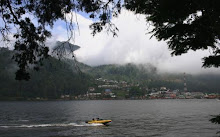diambil dari >>> k21st.wordpress.com/
With catalysts created by an MIT chemist, sunlight can turn water into hydrogen. If the process can scale up, it could make solar power a dominant source of energy.
via Technology Review: Sun + Water = Fuel
“I’m going to show you something I haven’t showed anybody yet,” said Daniel Nocera, a professor of chemistry at MIT, speaking this May to an auditorium filled with scientists and U.S. government energy officials. He asked the house manager to lower the lights. Then he started a video. “Can you see that?” he asked excitedly, pointing to the bubbles rising from a strip of material immersed in water. “Oxygen is pouring off of this electrode.” Then he added, somewhat cryptically, “This is the future. We’ve got the leaf.”

What Nocera was demonstrating was a reaction that generates oxygen from water much as green plants do during photosynthesis–an achievement that could have profound implications for the energy debate. Carried out with the help of a catalyst he developed, the reaction is the first and most difficult step in splitting water to make hydrogen gas. And efficiently generating hydrogen from water, Nocera believes, will help surmount one of the main obstacles preventing solar power from becoming a dominant source of electricity: there’s no cost-effective way to store the energy collected by solar panels so that it can be used at night or during cloudy days.
Imitating Plants
In real photosynthesis, green plants use chlorophyll to capture energy from sunlight and then use that energy to drive a series of complex chemical reactions that turn water and carbon dioxide into energy-rich carbohydrates such as starch and sugar. But what primarily interests many researchers is an early step in the process, in which a combination of proteins and inorganic catalysts helps break water efficiently into oxygen and hydrogen ions.

Photosynthesis in a beaker: In an experimental setup that duplicates the benign conditions found in photosynthetic plants, -Daniel ¬Nocera has demonstrated an easy and potentially cheap way to produce hydrogen gas. When a voltage is applied, cobalt and phosphate in solution (left) accumulate on an electrode to form a catalyst, which releases oxygen gas from the water as electrons flow out through the electrode. Hydrogen ions flow through a membrane; on the other side, hydrogen gas is produced by a nickel metal catalyst (Nocera has also used a platinum catalyst). Credit: Bryan Christie
The Artificial Leaf
Michael Grätzel, however, may have a clever way to turn Nocera’s discovery to practical use. A professor of chemistry and chemical engineering at the École Polytechnique Fédérale in Lausanne, Switzerland, he was one of the first people Nocera told about his new catalyst. “He was so excited,” Grätzel says. “He took me to a restaurant and bought a tremendously expensive bottle of wine.”
In 1991, Grätzel invented a promising new type of solar cell. It uses a dye containing ruthenium, which acts much like the chlorophyll in a plant, absorbing light and releasing electrons. In Grätzel’s solar cell, however, the electrons don’t set off a water-splitting reaction. Instead, they’re collected by a film of titanium dioxide and directed through an external circuit, generating electricity. Grätzel now thinks that he can integrate his solar cell and Nocera’s catalyst into a single device that captures the energy from sunlight and uses it to split water.
If he’s right, it would be a significant step toward making a device that, in many ways, truly resembles a leaf. The idea is that Grätzel’s dye would take the place of the electrode on which the catalyst forms in Nocera’s system. The dye itself, when exposed to light, can generate the voltage needed to assemble the catalyst. “The dye acts like a molecular wire that conducts charges away,” Grätzel says. The catalyst then assembles where it’s needed, right on the dye. Once the catalyst is formed, the sunlight absorbed by the dye drives the reactions that split water. Grätzel says that the device could be more efficient and cheaper than using a separate solar panel and electrolyzer.
Another possibility that Nocera is investigating is whether his catalyst can be used to split seawater. In initial tests, it performs well in the presence of salt, and he is now testing it to see how it handles other compounds found in the sea. If it works, Nocera’s system could address more than just the energy crisis; it could help solve the world’s growing shortage of fresh water as well.
Artificial leaves and fuel-producing desalination systems might sound like grandiose promises. But to many scientists, such possibilities seem maddeningly close; chemists seeking new energy technologies have been taunted for decades by the fact that plants easily use sunlight to turn abundant materials into energy-rich molecules. “We see it going on all around us, but it’s something we can’t really do,” says Paul Alivisatos, a professor of chemistry and materials science at the University of California, Berkeley, who is leading an effort at Lawrence Berkeley National Laboratory to imitate photosynthesis by chemical means.

Solar goes solo: Artificial photosynthesis could provide a practical way to store energy produced by solar power, freeing people’s homes from the electrical grid. In this scheme, electricity from solar panels powers an electrolyzer, which breaks water into hydrogen and oxygen. The hydrogen is stored; at night or on cloudy days, it is fed into a fuel cell to produce electricity for lights, appliances, and even electric cars. On sunny days, some of the solar power is used directly, bypassing the hydrogen production step. Credit: Bryan Christie



0 komentar:
Posting Komentar